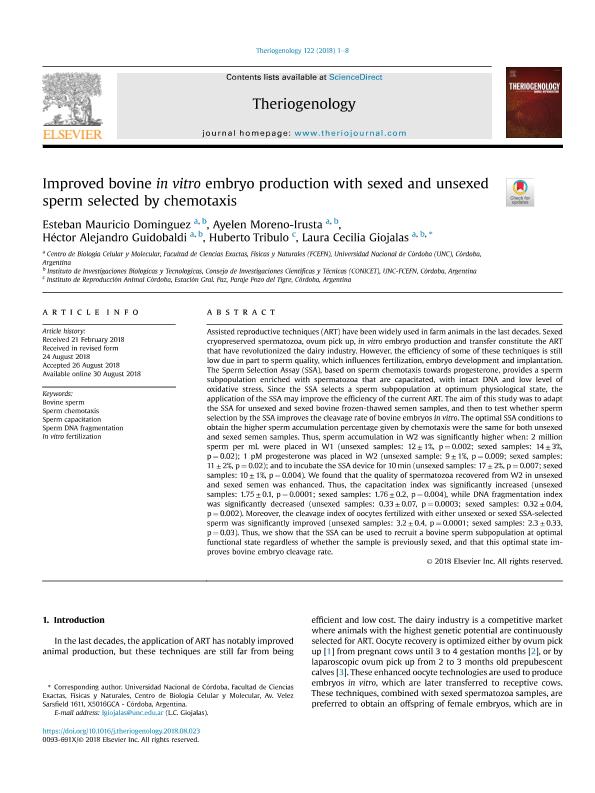Mostrar el registro sencillo del ítem
dc.contributor.author
Dominguez, Esteban Mauricio

dc.contributor.author
Moreno, Ayelen

dc.contributor.author
Guidobaldi, Héctor Alejandro

dc.contributor.author
Tribulo, Humberto Elias

dc.contributor.author
Giojalas, Laura Cecilia

dc.date.available
2019-10-23T13:04:38Z
dc.date.issued
2018-12
dc.identifier.citation
Dominguez, Esteban Mauricio; Moreno, Ayelen; Guidobaldi, Héctor Alejandro; Tribulo, Humberto Elias; Giojalas, Laura Cecilia; Improved bovine in vitro embryo production with sexed and unsexed sperm selected by chemotaxis; Elsevier Science Inc; Theriogenology; 122; 12-2018; 1-8
dc.identifier.issn
0093-691X
dc.identifier.uri
http://hdl.handle.net/11336/87050
dc.description.abstract
Assisted reproductive techniques (ART) have been widely used in farm animals in the last decades. Sexed cryopreserved spermatozoa, ovum pick up, in vitro embryo production and transfer constitute the ART that have revolutionized the dairy industry. However, the efficiency of some of these techniques is still low due in part to sperm quality, which influences fertilization, embryo development and implantation. The Sperm Selection Assay (SSA), based on sperm chemotaxis towards progesterone, provides a sperm subpopulation enriched with spermatozoa that are capacitated, with intact DNA and low level of oxidative stress. Since the SSA selects a sperm subpopulation at optimum physiological state, the application of the SSA may improve the efficiency of the current ART. The aim of this study was to adapt the SSA for unsexed and sexed bovine frozen-thawed semen samples, and then to test whether sperm selection by the SSA improves the cleavage rate of bovine embryos in vitro. The optimal SSA conditions to obtain the higher sperm accumulation percentage given by chemotaxis were the same for both unsexed and sexed semen samples. Thus, sperm accumulation in W2 was significantly higher when: 2 million sperm per mL were placed in W1 (unsexed samples: 12 ± 1%, p = 0.002; sexed samples: 14 ± 3%, p = 0.02); 1 pM progesterone was placed in W2 (unsexed sample: 9 ± 1%, p = 0.009; sexed samples: 11 ± 2%, p = 0.02); and to incubate the SSA device for 10 min (unsexed samples: 17 ± 2%, p = 0.007; sexed samples: 10 ± 1%, p = 0.004). We found that the quality of spermatozoa recovered from W2 in unsexed and sexed semen was enhanced. Thus, the capacitation index was significantly increased (unsexed samples: 1.75 ± 0.1, p = 0.0001; sexed samples: 1.76 ± 0.2, p = 0.004), while DNA fragmentation index was significantly decreased (unsexed samples: 0.33 ± 0.07, p = 0.0003; sexed samples: 0.32 ± 0.04, p = 0.002). Moreover, the cleavage index of oocytes fertilized with either unsexed or sexed SSA-selected sperm was significantly improved (unsexed samples: 3.2 ± 0.4, p = 0.0001; sexed samples: 2.3 ± 0.33, p = 0.03). Thus, we show that the SSA can be used to recruit a bovine sperm subpopulation at optimal functional state regardless of whether the sample is previously sexed, and that this optimal state improves bovine embryo cleavage rate.
dc.format
application/pdf
dc.language.iso
eng
dc.publisher
Elsevier Science Inc

dc.rights
info:eu-repo/semantics/openAccess
dc.rights.uri
https://creativecommons.org/licenses/by-nc-sa/2.5/ar/
dc.subject
BOVINE SPERM
dc.subject
SPERM CHEMOTAXIS
dc.subject
SPERM CAPACITATION
dc.subject
SPERM DNA FRAGMENTATION
dc.subject
IN VITRO FERTILIZATION
dc.subject.classification
Biología Celular, Microbiología

dc.subject.classification
Ciencias Biológicas

dc.subject.classification
CIENCIAS NATURALES Y EXACTAS

dc.title
Improved bovine in vitro embryo production with sexed and unsexed sperm selected by chemotaxis
dc.type
info:eu-repo/semantics/article
dc.type
info:ar-repo/semantics/artículo
dc.type
info:eu-repo/semantics/publishedVersion
dc.date.updated
2019-08-09T15:05:01Z
dc.journal.volume
122
dc.journal.pagination
1-8
dc.journal.pais
Países Bajos

dc.journal.ciudad
Amsterdam
dc.description.fil
Fil: Dominguez, Esteban Mauricio. Consejo Nacional de Investigaciones Científicas y Técnicas. Centro Científico Tecnológico Conicet - Córdoba. Instituto de Investigaciones Biológicas y Tecnológicas. Universidad Nacional de Córdoba. Facultad de Ciencias Exactas, Físicas y Naturales. Instituto de Investigaciones Biológicas y Tecnológicas; Argentina. Universidad Nacional de Córdoba. Facultad de Ciencias Exactas, Físicas y Naturales. Centro de Biología Celular y Molecular; Argentina
dc.description.fil
Fil: Moreno, Ayelen. Consejo Nacional de Investigaciones Científicas y Técnicas. Centro Científico Tecnológico Conicet - Córdoba. Instituto de Investigaciones Biológicas y Tecnológicas. Universidad Nacional de Córdoba. Facultad de Ciencias Exactas, Físicas y Naturales. Instituto de Investigaciones Biológicas y Tecnológicas; Argentina. Universidad Nacional de Córdoba. Facultad de Ciencias Exactas, Físicas y Naturales. Centro de Biología Celular y Molecular; Argentina
dc.description.fil
Fil: Guidobaldi, Héctor Alejandro. Consejo Nacional de Investigaciones Científicas y Técnicas. Centro Científico Tecnológico Conicet - Córdoba. Instituto de Investigaciones Biológicas y Tecnológicas. Universidad Nacional de Córdoba. Facultad de Ciencias Exactas, Físicas y Naturales. Instituto de Investigaciones Biológicas y Tecnológicas; Argentina. Universidad Nacional de Córdoba. Facultad de Ciencias Exactas, Físicas y Naturales. Centro de Biología Celular y Molecular; Argentina
dc.description.fil
Fil: Tribulo, Humberto Elias. Instituto de Reproduccion Animal Córdoba; Argentina
dc.description.fil
Fil: Giojalas, Laura Cecilia. Consejo Nacional de Investigaciones Científicas y Técnicas. Centro Científico Tecnológico Conicet - Córdoba. Instituto de Investigaciones Biológicas y Tecnológicas. Universidad Nacional de Córdoba. Facultad de Ciencias Exactas, Físicas y Naturales. Instituto de Investigaciones Biológicas y Tecnológicas; Argentina. Universidad Nacional de Córdoba. Facultad de Ciencias Exactas, Físicas y Naturales. Centro de Biología Celular y Molecular; Argentina
dc.journal.title
Theriogenology

dc.relation.alternativeid
info:eu-repo/semantics/altIdentifier/doi/http://dx.doi.org/10.1016/j.theriogenology.2018.08.023
dc.relation.alternativeid
info:eu-repo/semantics/altIdentifier/url/https://www.sciencedirect.com/science/article/pii/S0093691X18307209
Archivos asociados
